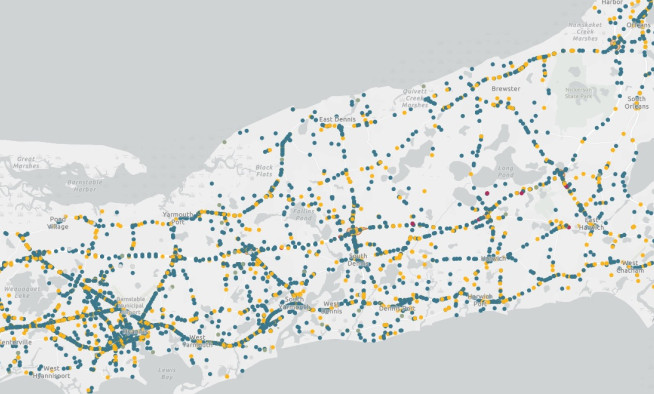Strategies to strengthen the region’s vulnerable roadways
Low-Lying Roads project nears completion
Cape Cod’s unique geography and roadways that travel through ever-changing environments mean that the region is especially vulnerable to the impacts of coastal storms. Flooding is a regular event on several road segments during extreme high tides and storm events. As seas rise and storms intensify, the impact on Cape Cod’s coastlines, including flooding occurrences, will increase in frequency and depth.
The Cape Cod Climate Action Plan includes key strategies to address vulnerability in our public infrastructure, specifically in its roadway network. In 2021, the Commission began work on the Low-Lying Roads Project, an effort to assess and analyze the region’s low-lying roads and to devise solutions that towns can implement to increase their resiliency in the face of increased climate impacts. The project will be complete in 2024, with vulnerable roads identified and solutions presented in all 15 Cape Cod towns.
With funding support from the U.S. Economic Development Administration and the Massachusetts Municipal Vulnerability Preparedness (MVP) Program, the Commission contracted with the Woods Hole Group to conduct a vulnerability assessment of roadway segments, bridges, and culverts due to flooding from the combined effects of sea level rise and storm surge. The project employs state-of-the-art modeling and community engagement to identify and prioritize low-lying roads to target coastal resiliency action.
The towns of Barnstable, Bourne, Brewster, Dennis, Eastham, Orleans, Sandwich, Wellfleet, Truro, and Yarmouth were the first towns to undergo the modeling and analysis and receive design solutions for two road segments, concluding in Spring 2023. Modeling and analysis for Chatham, Falmouth, Mashpee, Harwich, and Provincetown are underway. Work under this second MVP Action grant will conclude in June 2024.
Using the Massachusetts Coast Flood Risk Model (MC-FRM), a state-developed resource that includes important data such as future projections for flooding and sea level rise, historic storm tracks, and models of future tracks, the team examined roads and bridges at three future time horizons: 2030, 2050, and 2070 to develop a criticality assessment to help towns prioritize the identified vulnerable roads. In workshops held in each town, the group presented the vulnerability and prioritization analyses. The team used feedback from stakeholders and community members to inform the selection of two priority road segments and begin to design adaptation solutions.
Finding a way to improve these roads and reduce vulnerability is complex. In some cases, especially where roads are adjacent to sensitive wetland resources, costly traditional solutions with a significant environmental footprint, like putting in steel bulkheads, extensive fill, or a bridge, may be the only way to address the problem. Nature-based or hybrid solutions exist that can buy the community considerable time, such as opening a culvert or creating a vegetated berm – both of which can decrease vulnerability and positively impact water quality and the environment.
For the most part, community members engaged in the process were not surprised by the road segments illustrated as vulnerable in the short term, as many low-lying areas are already prone to flooding. However, some of the longer-term vulnerabilities were not as obvious, and eye-opening in terms of thinking of future planning efforts.
The benefits of the low-lying roads project go beyond simply identifying solutions for a pair of roads in town. The mapping, prioritization, and identification of the most vulnerable roads in town will impact future resilience plans and the resulting online tools have created a resource that towns can use now and in the future.
Learn more about the Low Lying Roads project: www.capecodcommission.org/llr
Related Posts




